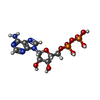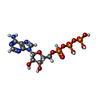[English] 日本語
 Yorodumi
Yorodumi- EMDB-51229: CryoEM structure of the human INO80 core- H2A.Z nucleosome complex -
+ Open data
Open data
- Basic information
Basic information
| Entry |  | |||||||||
|---|---|---|---|---|---|---|---|---|---|---|
| Title | CryoEM structure of the human INO80 core- H2A.Z nucleosome complex | |||||||||
 Map data Map data | ||||||||||
 Sample Sample |
| |||||||||
 Keywords Keywords | Homo sapiens / ATP-dependent chromatin remodeller / DNA BINDING PROTEIN | |||||||||
| Function / homology |  Function and homology information Function and homology informationpositive regulation of nuclear cell cycle DNA replication / promoter-enhancer loop anchoring activity / telomerase RNA localization to Cajal body / regulation of DNA strand elongation / positive regulation of telomere maintenance in response to DNA damage / establishment of protein localization to chromatin / R2TP complex / dynein axonemal particle / Swr1 complex / RPAP3/R2TP/prefoldin-like complex ...positive regulation of nuclear cell cycle DNA replication / promoter-enhancer loop anchoring activity / telomerase RNA localization to Cajal body / regulation of DNA strand elongation / positive regulation of telomere maintenance in response to DNA damage / establishment of protein localization to chromatin / R2TP complex / dynein axonemal particle / Swr1 complex / RPAP3/R2TP/prefoldin-like complex / Ino80 complex / ATP-dependent chromatin remodeler activity / regulation of double-strand break repair / UV-damage excision repair / box C/D snoRNP assembly / protein folding chaperone complex / nucleosomal DNA binding / regulation of chromosome organization / NuA4 histone acetyltransferase complex / TFIID-class transcription factor complex binding / regulation of DNA replication / mitotic sister chromatid segregation / regulation of G1/S transition of mitotic cell cycle / MLL1 complex / regulation of embryonic development / Telomere Extension By Telomerase / ATP-dependent activity, acting on DNA / alpha-tubulin binding / RNA polymerase II core promoter sequence-specific DNA binding / regulation of DNA repair / negative regulation of megakaryocyte differentiation / heterochromatin / positive regulation of double-strand break repair via homologous recombination / protein localization to CENP-A containing chromatin / spindle assembly / Chromatin modifying enzymes / Replacement of protamines by nucleosomes in the male pronucleus / CENP-A containing nucleosome / Packaging Of Telomere Ends / Recognition and association of DNA glycosylase with site containing an affected purine / Cleavage of the damaged purine / Deposition of new CENPA-containing nucleosomes at the centromere / Recognition and association of DNA glycosylase with site containing an affected pyrimidine / Cleavage of the damaged pyrimidine / telomere maintenance / telomere organization / DNA helicase activity / Interleukin-7 signaling / Inhibition of DNA recombination at telomere / RNA Polymerase I Promoter Opening / Meiotic synapsis / TBP-class protein binding / positive regulation of DNA repair / Assembly of the ORC complex at the origin of replication / SUMOylation of chromatin organization proteins / Regulation of endogenous retroelements by the Human Silencing Hub (HUSH) complex / epigenetic regulation of gene expression / DNA methylation / Condensation of Prophase Chromosomes / Chromatin modifications during the maternal to zygotic transition (MZT) / SIRT1 negatively regulates rRNA expression / HCMV Late Events / innate immune response in mucosa / ERCC6 (CSB) and EHMT2 (G9a) positively regulate rRNA expression / PRC2 methylates histones and DNA / cellular response to ionizing radiation / Regulation of endogenous retroelements by KRAB-ZFP proteins / Defective pyroptosis / HDACs deacetylate histones / Regulation of endogenous retroelements by Piwi-interacting RNAs (piRNAs) / Nonhomologous End-Joining (NHEJ) / RNA Polymerase I Promoter Escape / cellular response to estradiol stimulus / Transcriptional regulation by small RNAs / negative regulation of canonical Wnt signaling pathway / euchromatin / Formation of the beta-catenin:TCF transactivating complex / double-strand break repair via homologous recombination / Activated PKN1 stimulates transcription of AR (androgen receptor) regulated genes KLK2 and KLK3 / RUNX1 regulates genes involved in megakaryocyte differentiation and platelet function / HDMs demethylate histones / DNA Damage Recognition in GG-NER / G2/M DNA damage checkpoint / ADP binding / beta-catenin binding / NoRC negatively regulates rRNA expression / chromatin DNA binding / DNA Damage/Telomere Stress Induced Senescence / B-WICH complex positively regulates rRNA expression / PKMTs methylate histone lysines / Hydrolases; Acting on acid anhydrides; Acting on acid anhydrides to facilitate cellular and subcellular movement / Meiotic recombination / Pre-NOTCH Transcription and Translation / spindle / RMTs methylate histone arginines / Activation of anterior HOX genes in hindbrain development during early embryogenesis / nuclear matrix / fibrillar center / Transcriptional regulation of granulopoiesis / HCMV Early Events Similarity search - Function | |||||||||
| Biological species |  Homo sapiens (human) / synthetic construct (others) Homo sapiens (human) / synthetic construct (others) | |||||||||
| Method | single particle reconstruction / cryo EM / Resolution: 3.43 Å | |||||||||
 Authors Authors | Aggarwal P / Sharma M / Hopfner KP | |||||||||
| Funding support | European Union,  Germany, 2 items Germany, 2 items
| |||||||||
 Citation Citation |  Journal: To Be Published Journal: To Be PublishedTitle: Recognition and remodelling of nucleosomes and hexasomes by the human INO80 complex Authors: Aggarwal P / Sharma M / Hopfner KP | |||||||||
| History |
|
- Structure visualization
Structure visualization
| Supplemental images |
|---|
- Downloads & links
Downloads & links
-EMDB archive
| Map data |  emd_51229.map.gz emd_51229.map.gz | 162.8 MB |  EMDB map data format EMDB map data format | |
|---|---|---|---|---|
| Header (meta data) |  emd-51229-v30.xml emd-51229-v30.xml emd-51229.xml emd-51229.xml | 38.4 KB 38.4 KB | Display Display |  EMDB header EMDB header |
| Images |  emd_51229.png emd_51229.png | 71.5 KB | ||
| Filedesc metadata |  emd-51229.cif.gz emd-51229.cif.gz | 10.1 KB | ||
| Others |  emd_51229_half_map_1.map.gz emd_51229_half_map_1.map.gz emd_51229_half_map_2.map.gz emd_51229_half_map_2.map.gz | 301.2 MB 301.2 MB | ||
| Archive directory |  http://ftp.pdbj.org/pub/emdb/structures/EMD-51229 http://ftp.pdbj.org/pub/emdb/structures/EMD-51229 ftp://ftp.pdbj.org/pub/emdb/structures/EMD-51229 ftp://ftp.pdbj.org/pub/emdb/structures/EMD-51229 | HTTPS FTP |
-Validation report
| Summary document |  emd_51229_validation.pdf.gz emd_51229_validation.pdf.gz | 1.1 MB | Display |  EMDB validaton report EMDB validaton report |
|---|---|---|---|---|
| Full document |  emd_51229_full_validation.pdf.gz emd_51229_full_validation.pdf.gz | 1.1 MB | Display | |
| Data in XML |  emd_51229_validation.xml.gz emd_51229_validation.xml.gz | 17 KB | Display | |
| Data in CIF |  emd_51229_validation.cif.gz emd_51229_validation.cif.gz | 20.5 KB | Display | |
| Arichive directory |  https://ftp.pdbj.org/pub/emdb/validation_reports/EMD-51229 https://ftp.pdbj.org/pub/emdb/validation_reports/EMD-51229 ftp://ftp.pdbj.org/pub/emdb/validation_reports/EMD-51229 ftp://ftp.pdbj.org/pub/emdb/validation_reports/EMD-51229 | HTTPS FTP |
-Related structure data
| Related structure data |  9gcgMC  9ge4C  9ge5C  9gelC M: atomic model generated by this map C: citing same article ( |
|---|---|
| Similar structure data | Similarity search - Function & homology  F&H Search F&H Search |
- Links
Links
| EMDB pages |  EMDB (EBI/PDBe) / EMDB (EBI/PDBe) /  EMDataResource EMDataResource |
|---|---|
| Related items in Molecule of the Month |
- Map
Map
| File |  Download / File: emd_51229.map.gz / Format: CCP4 / Size: 325 MB / Type: IMAGE STORED AS FLOATING POINT NUMBER (4 BYTES) Download / File: emd_51229.map.gz / Format: CCP4 / Size: 325 MB / Type: IMAGE STORED AS FLOATING POINT NUMBER (4 BYTES) | ||||||||||||||||||||||||||||||||||||
|---|---|---|---|---|---|---|---|---|---|---|---|---|---|---|---|---|---|---|---|---|---|---|---|---|---|---|---|---|---|---|---|---|---|---|---|---|---|
| Projections & slices | Image control
Images are generated by Spider. | ||||||||||||||||||||||||||||||||||||
| Voxel size | X=Y=Z: 0.943 Å | ||||||||||||||||||||||||||||||||||||
| Density |
| ||||||||||||||||||||||||||||||||||||
| Symmetry | Space group: 1 | ||||||||||||||||||||||||||||||||||||
| Details | EMDB XML:
|
-Supplemental data
-Half map: #1
| File | emd_51229_half_map_1.map | ||||||||||||
|---|---|---|---|---|---|---|---|---|---|---|---|---|---|
| Projections & Slices |
| ||||||||||||
| Density Histograms |
-Half map: #2
| File | emd_51229_half_map_2.map | ||||||||||||
|---|---|---|---|---|---|---|---|---|---|---|---|---|---|
| Projections & Slices |
| ||||||||||||
| Density Histograms |
- Sample components
Sample components
+Entire : Human INO80 remodeller with H2A.Z containing nucleosomes
+Supramolecule #1: Human INO80 remodeller with H2A.Z containing nucleosomes
+Supramolecule #2: Human INO80 remodeller
+Supramolecule #3: Histone Octamer
+Supramolecule #4: Synthetic deoxyribonucleic acid
+Macromolecule #1: RuvB-like 1
+Macromolecule #2: RuvB-like 2
+Macromolecule #3: INO80 complex subunit C
+Macromolecule #4: Chromatin-remodeling ATPase INO80
+Macromolecule #5: INO80 complex subunit B
+Macromolecule #6: Actin-related protein 5
+Macromolecule #9: Histone H3.1
+Macromolecule #10: Histone H4
+Macromolecule #11: Histone H2A.Z
+Macromolecule #12: Histone H2B type 2-E
+Macromolecule #13: Histone H2A.Z
+Macromolecule #7: Nucleosomal DNA Strand 1 (152-MER)
+Macromolecule #8: Nucleosomal DNA Strand 2 (152-MER)
+Macromolecule #14: ADENOSINE-5'-DIPHOSPHATE
+Macromolecule #15: ADENOSINE-5'-TRIPHOSPHATE
+Macromolecule #16: ZINC ION
-Experimental details
-Structure determination
| Method | cryo EM |
|---|---|
 Processing Processing | single particle reconstruction |
| Aggregation state | particle |
- Sample preparation
Sample preparation
| Buffer | pH: 8 Component:
| ||||||||||||
|---|---|---|---|---|---|---|---|---|---|---|---|---|---|
| Grid | Model: Quantifoil R2/1 / Material: COPPER / Mesh: 200 / Pretreatment - Type: GLOW DISCHARGE / Pretreatment - Time: 7 sec. / Details: Negative Polarity | ||||||||||||
| Vitrification | Cryogen name: ETHANE / Chamber humidity: 95 % / Chamber temperature: 283 K / Instrument: LEICA EM GP |
- Electron microscopy
Electron microscopy
| Microscope | FEI TITAN KRIOS |
|---|---|
| Image recording | Film or detector model: GATAN K2 SUMMIT (4k x 4k) / Average electron dose: 1.0 e/Å2 |
| Electron beam | Acceleration voltage: 300 kV / Electron source:  FIELD EMISSION GUN FIELD EMISSION GUN |
| Electron optics | Illumination mode: FLOOD BEAM / Imaging mode: BRIGHT FIELD / Cs: 2.7 mm / Nominal defocus max: 2.9 µm / Nominal defocus min: 1.1 µm |
| Experimental equipment |  Model: Titan Krios / Image courtesy: FEI Company |
+ Image processing
Image processing
-Atomic model buiding 1
| Refinement | Space: RECIPROCAL / Protocol: FLEXIBLE FIT / Overall B value: 134.96 / Target criteria: MAXIMUM LIKELIHOOD WITH PHASES |
|---|---|
| Output model |  PDB-9gcg: |
 Movie
Movie Controller
Controller











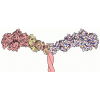
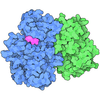
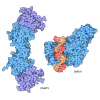

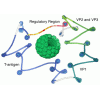


 Z (Sec.)
Z (Sec.) Y (Row.)
Y (Row.) X (Col.)
X (Col.)




































 Trichoplusia ni (cabbage looper)
Trichoplusia ni (cabbage looper)
